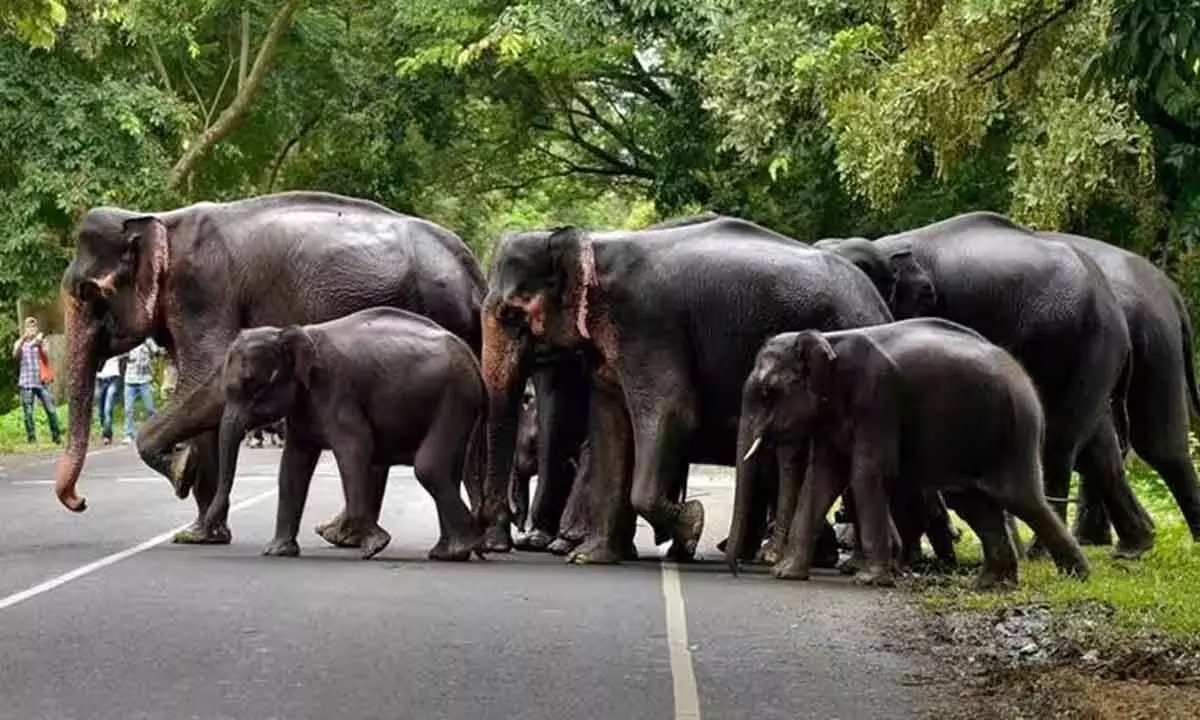Live
- AIBOC warns of agitation
- 4 held from Gujarat in ‘digital arrest’ case
- 10 held for attack on MLA Himanshu
- BJD refutes allegations of Adani paying bribe to officials
- Will move Supreme Court if no action over MLA disqualification; KTR
- UN committed to communicating in Hindi, will expand programme: Official
- Food Safety Task Force raids nutraceutical manufacturing units
- TG govt fills over 53K vacancies in 1 yr
- DCP asks business entities to strengthen surveillance systems
- Caste survey crosses ‘1 crore’ milestone
Just In
Jumbo rise in number of elephants in state: Eshwar Khandre


The World Elephant Day is being celebrated on August 12 to create awareness about conservation of their habitat so that they can also live comfortably
Bengaluru: Forest Ecology and Environment Minister Eshwar B Khandre said that the number of elephants in the state has increased by about 350 percent. Minister Eshwar Khandre released the elephant census report at a press conference at his office at Vikas Soudha, and said that in 2017, there were about 6,049 elephants in the state, and this time, it was estimated that there were 6,395 elephants, an increase of about 350 percent.
Although elephants are mighty wildlife species, they are under threat worldwide, including in India. In order to protect the endangered elephants, the World Elephant Day is being celebrated from August 12, 2012 to create awareness about conservation of their habitat so that the elephants can also live comfortably.
An elephant census is conducted every five years to find out whether the number of elephants in the country has increased or decreased on Elephant Day. The previous elephant census was held in 2017.
Later, in 2022, an attempt was made to make the elephant census a part of the All India Tiger Census. But this survey did not include sample block count and population structure assessment of elephants. This method is very important for census and numerical classification of elephants i.e. sex and age.
The elephant census was conducted simultaneously from May 17 to May 19 with the leadership of these three states Karnataka, Kerala and Tamil Nadu. He explained that a similar census was conducted in Andhra Pradesh on the same date. The elephant census was conducted by the Karnataka Forest Department with technical assistance from the Indian Institute of Science (IISC) headed by R Sukumar.
More than 3400 personnel from 32 divisions of the state participated in this elephant census. Elephant counting was done in three methods:
Direct Count or Block Ladder: In this method direct enumeration of elephants was carried out in different sampling blocks of 5.0 sq km area and covered about 30 to 50 per cent of the total number of beats.
Transect Survey or Dung Count Method: In this method a survey was conducted along transect lines of 2 km length and the number of elephant dung piles was counted. The data is being processed to get information on the number of elephants through these statistical models and the results will be available soon.
Waterhole Count The work was carried out in direct sight of the elephants at waterholes and other places regularly visited by the elephants. In this method, movement of elephants, age groups, male to female ratio etc. are recorded, he said.
Elephant census was conducted in 32 divisions of the state and elephants were found in 23 divisions in this survey. The total number of elephants enumerated directly on the day of survey was 2219. The survey was conducted in 6104 sq km area out of 18975 sq km area in these 23 divisions. He informed that this survey and report will be more accurate and reliable as this is the first time such a large area has been surveyed.
Additional Chief Secretary of Forest Biology and Environment Department Javed Akhtar, senior officials of Forest Department Subhash Malkede, Kumar Pushkar, Sanjay Bijjur, Smita Bijjur and others were present during the release of the elephant report.
Remote sensing
technology for forest
wildlife conservation
The Minister of Forests, Biology and Environment said that the State Forest Department is using modern technology for conservation and management of natural resources, wildlife.
Releasing a manual on the use of AIS, GIS and remote sensing technology for forest and wildlife conservation and management, he said that keeping in mind the thinning boundary between human-wildlife habitats, increasing pressure on forests and natural resources, it has been decided to use technology for the conservation of forests and wildlife and biodiversity. Internal and external evaluation of forest works of the department is being done through e-evaluation, android app and web system. With the help of this, the capacity report of various projects and plantations is being obtained, he said.
The minister also said that the forest land software will include satellite photography of notified forest areas and forest village map with computerized geographical information.

© 2024 Hyderabad Media House Limited/The Hans India. All rights reserved. Powered by hocalwire.com






